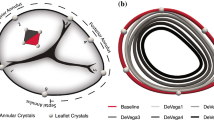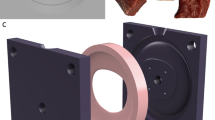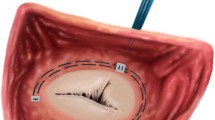Abstract
Tricuspid regurgitation (TR) is present in trace amounts or more in 82–86% of the population and is greater than mild in 14% of the population. In severe cases, it can contribute to right heart failure and adversely affect mitral valve repair durability. One major cause of TR is the dilation of the tricuspid annulus, which alters the geometry of the annulus from a saddle-shape to a more planar profile. Another cause of TR is the displacement of the papillary muscles (PMs), which results from right ventricular dilation. The objective of this study was to identify the effect of a saddle-shaped annulus on native tricuspid leaflet stretch mechanics and TR. In addition, the effects of geometric alterations, including annular dilatation and PM displacement, on leaflet stretch was investigated. Fresh porcine tricuspid valves (TVs) (n = 8) were excised and sutured to an adjustable three-dimensional annulus plate (allowing for dilatation and saddle-shape) and three PM attachment rods. The valve was then placed in the in vitro Georgia Tech right heart simulator. Dual-camera photogrammetry, was used to quantify the stretch ratio experienced by the valve leaflets at peak systole for the following conditions: physiologically normal, 100% annular dilatation, displaced PMs, and a combination of annular dilatation and PM displacement. In addition, a saddle and flat annulus were implemented for each of the four conditions. PM displacement was simulated by displacing all PMs by 10 mm in all directions (laterally, apically, posteriorly/anteriorly). The physiologically normal condition—normal annulus area, saddle-shaped annulus with PMs in a normal position, was used as a control. The results showed that the posterior leaflet exhibited significantly (p ≤ 0.05) higher major and areal stretch ratios as compared to the anterior leaflet at peak systole for all conditions tested. No significant difference was seen in stretch when a flat annulus was compared to saddle for the anterior or posterior leaflet for normal or disease conditions. Investigation of the impact of disease found a significant increase (p ≤ 0.10) in stretch in the posterior leaflet with a combination of annular dilatation and PM displacement (2.01 ± 0.68) as compared to the normal condition with a saddle annulus (1.43 ± 0.20). In addition displacement of the PMs resulted in a significant (p ≤ 0.01) reduction in TR, although the actual volume reduced was minimal (1.2 mL). Stretch values were measured for the anterior and posterior leaflet under both physiologic and pathologic conditions for the first time. Further, these results provide an understanding of the effects of geometric parameters on valve mechanics and function, which may lead to improved TV repairs.






Similar content being viewed by others
References
Antunes, M. J., and J. B. Barlow. Management of tricuspid valve regurgitation. Heart 93(2):271–276, 2007.
Anyanwu, A. C., J. Chikwe, and D. H. Adams. Tricuspid valve repair for treatment and prevention of secondary tricuspid regurgitation in patients undergoing mitral valve surgery. Curr. Cardiol. Rep. 10(2):110–117, 2008.
Chen, L., F. C. P. Yin, and K. May-Newman. The structure and mechanical properties of the mitral valve leaflet-strut chordae transition zone. J. Biomech. Eng. Trans. ASME 126(2):244–251, 2004.
Dreyfus, G. D., P. J. Corbi, J. Chan, and T. Bahrami. Secondary tricuspid regurgitation or dilatation: which should be the criteria for surgical repair? Ann. Thorac. Surg. 79(1):127–132, 2005.
Fukuda, S., A. M. Gillinov, P. M. McCarthy, et al. Determinants of recurrent or residual functional tricuspid regurgitation after tricuspid annuloplasty. Circulation 114:I582–I587, 2006.
Grashow, J. S., A. P. Yoganathan, and M. S. Sacks. Biaixal stress–stretch behavior of the mitral valve anterior leaflet at physiologic strain rates. Ann. Biomed. Eng. 34(2):315–325, 2006.
He, Z., J. Ritchie, J. S. Grashow, M. S. Sacks, and A. P. Yoganathan. In vitro dynamic strain behavior of the mitral valve posterior leaflet. J. Biomech. Eng. 127(3):504–511, 2005.
He, Z. M., M. S. Sacks, L. Baijens, S. Wanant, P. Shah, and A. P. Yoganathan. Effects of papillary muscle position on in vitro dynamic strain on the porcine mitral valve. J. Heart Valve Dis. 12(4):488–494, 2003.
Jimenez, J. H., S. W. Liou, M. Padala, et al. A saddle-shaped annulus reduces systolic strain on the central region of the mitral valve anterior leaflet. J. Thorac. Cardiovasc. Surg. 134(6):1562–1568, 2007.
Kaplan, S. R., G. Bashein, F. H. Sheehan, et al. Three-dimensional echocardiographic assessment of annular shape changes in the normal and regurgitant mitral valve. Am. Heart J. 139(3):378–387, 2000.
Levine, R. A., M. O. Triulzi, P. Harrigan, and A. E. Weyman. The relationship of mitral annular shape to the diagnosis of mitral-valve prolapse. Circulation 75(4):756–767, 1987.
Marui, A., T. Mochizuki, N. Mitsui, T. Koyama, and M. Horibe. Isolated tricuspid regurgitation caused by a dilated tricuspid annulus. Ann. Thorac. Surg. 66(2):560–562, 1998.
Nath, J., E. Foster, and P. A. Heidenreich. Impact of tricuspid regurgitation on long-term survival. J. Am. Coll. Cardiol. 43(3):405–409, 2004.
Padala, M., R. A. Hutchison, L. R. Croft, et al. Saddle shape of the mitral annulus reduces systolic strains on the P2 segment of the posterior mitral leaflet. Ann. Thorac. Surg. 88(5):1499–1505, 2009.
Padala, M., M. S. Sacks, S. W. Liou, K. Balachandran, Z. M. He, and A. P. Yoganathan. Mechanics of the mitral valve strut chordae insertion region. J. Biomech. Eng. Trans. ASME 132(8):81004, 2010.
Park, Y. H., J. M. Song, E. Y. Lee, Y. J. Kim, D. H. Kang, and J. K. Song. Geometric and hemodynamic determinants of functional tricuspid regurgitation: a real-time three-dimensional echocardiography study. Int. J. Cardiol. 124(2):160–165, 2008.
Seo, H. S., J. W. Ha, J. Y. Moon, et al. Right ventricular remodeling and dysfunction with subsequent annular dilatation and tethering as a mechanism of isolated tricuspid regurgitation. Circ. J. 72(10):1645–1649, 2008.
Shah, P. M., and A. A. Raney. Tricuspid valve disease. Curr. Probl. Cardiol. 33(2):47–84, 2008.
Silver, M. D., J. H. Lam, N. Ranganathan, and E. D. Wigle. Morphology of the human tricuspid valve. Circulation 43(3):333–348, 1971.
Singh, J. P., J. C. Evans, D. Levy, et al. Prevalence and clinical determinants of mitral, tricuspid, and aortic regurgitation (the Framingham Heart Study). Am. J. Cardiol. 83(6):897–902, 1999.
Skwarek, M., J. Hreczecha, M. Dudziak, and M. Grzybiak. The morphology of the right atrioventricular valve in the adult human heart. Folia Morphol. (Warsz) 65(3):200–208, 2006.
Smith, D. B., M. S. Sacks, D. A. Vorp, and M. Thornton. Surface geometric analysis of anatomic structures using biquintic finite element interpolation. Ann. Biomed. Eng. 28(6):598–611, 2000.
Spinner, E. M., P. Shannon, D. Buice, et al. In vitro characterization of the mechanisms responsible for functional tricuspid regurgitation. Circulation 124(8):920–929, 2011.
Stevanella, M., E. Votta, M. Lemma, C. Antona, and A. Redaelli. Finite element modelling of the tricuspid valve: a preliminary study. Med. Eng. Phys. 32(10):1213–1223, 2010.
Tei, C., J. P. Pilgrim, P. M. Shah, J. A. Ormiston, and M. Wong. The tricuspid valve annulus: study of size and motion in normal subjects and in patients with tricuspid regurgitation. Circulation 66(3):665–671, 1982.
Ton-Nu, T. T., R. A. Levine, M. D. Handschumacher, et al. Geometric determinants of functional tricuspid regurgitation—insights from 3-dimensional echocardiography. Circulation 114(2):143–149, 2006.
Yap, C. H., H. S. Kim, K. Balachandran, M. Weiler, R. Haj-Ali, and A. P. Yoganathan. Dynamic deformation characteristics of porcine aortic valve leaflet under normal and hypertensive conditions. Am. J. Physiol. Heart Circ. Physiol. 298(2):H395–H405, 2010.
Acknowledgments
The authors thank Jean-Pierre Rabbah for his intellectual discussion and critical review of the manuscript and Holifield Farms for donation of the porcine hearts.
Funding
American Heart Association Predoctoral Fellowship 09PRE2380090, Wallace H. Coulter Distinguished Faculty Chair Endowment and Georgia Institute of Technology, Tom and Shirley Gurley and the Georgia Tech Presidential Undergraduate Research Award.
Author information
Authors and Affiliations
Corresponding author
Additional information
Associate Editor Jane Grande-Allen oversaw the review of this article.
Rights and permissions
About this article
Cite this article
Spinner, E.M., Buice, D., Yap, C.H. et al. The Effects of a Three-Dimensional, Saddle-Shaped Annulus on Anterior and Posterior Leaflet Stretch and Regurgitation of the Tricuspid Valve. Ann Biomed Eng 40, 996–1005 (2012). https://doi.org/10.1007/s10439-011-0471-6
Received:
Accepted:
Published:
Issue Date:
DOI: https://doi.org/10.1007/s10439-011-0471-6




